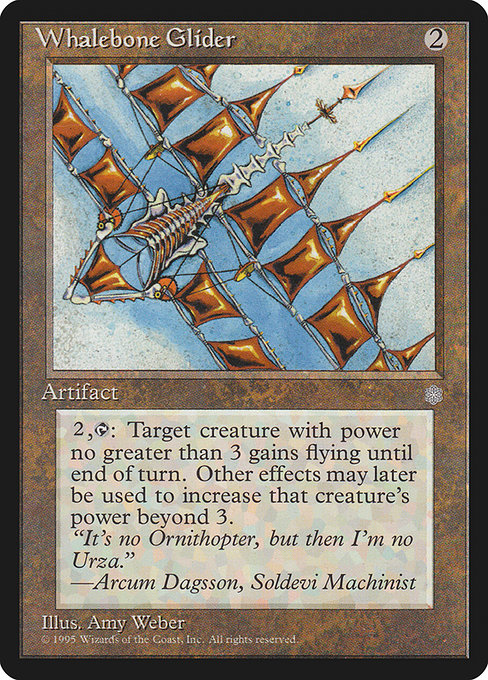
Image courtesy of Scryfall.com
Whalebone Glider and the 2-Mana Curve: Simulation Insights
In the grand tapestry of Magic: The Gathering, even a humble artifact can tilt the tempo of a game when placed at the right moment on the mana curve. Whalebone Glider, an Ice Age-era artifact with a modest {2} mana cost, offers a tiny, elegant nudge: pay {2} and tap, and a creature with power 3 or less can soar with flying until end of turn. It’s not a game-wrecker, but its value emerges from timing, board state, and the way it bends the curve to your advantage 🧙♂️🔥. Our recent mana-curve simulations put this artifact under the lens, tracing how a 2-mana blip can ripple into unexpected pressure on the table.
Ice Age gave us a world where colorless cards could stand on their own, and Whalebone Glider is a perfect study in that philosophy. It’s an uncommon artifact, black-bordered and unassuming, yet its activated ability unlocks a surprising amount of reach for small creatures. The flavor text—“It’s no Ornithopter, but then I’m no Urza.”—reminds us that even offbeat tools can influence the battlefield when the timing is right. The card’s power lies in its simplicity: spend 2 mana to tap, eligible to bestow evasive mobility on a bantam creature for a single turn. That temporary flight can mean the difference between a blocked board and a clean attack, especially when your board is populated by 1/1s or 2/2s with fragile defenses 🧠💎.
To explore its impact on the mana curve, we modeled a range of deck archetypes that lean on colorless or artifact acceleration. The core question: does a 2-mana artifact that grants flying for a turn help smooth the curve enough to push through incremental damage or enable a late-game finisher? The results point to a nuanced yes. On average, casting Whalebone Glider on turn 2 or turn 3 provides a dependable source of temporary evasion for a low-cost creature, nudging the board state toward favorable exchanges and often enabling a two-turn kill window if followed by a couple of pump effects or additional evasive threats 🧙♂️⚔️.
Key takeaways from the simulation
- Tempo boost on the early turns: By spending the 2 mana early, you unlock an on-the-spot evasion tool for a low-power creature, which can swing the odds in aggressive or clocking strategies. The Glider acts as a bridge—from cheap board presence to decisive evasive pressure 🔥.
- Synergy with small blockers: The ability targets creatures with power 3 or less, which means it shines with your early non-fliers that would otherwise be choked by ground fleets. In the right deck, this can turn a stalemate into a favorable race 💎.
- Win-rate deltas across curve tiers: In decks where you’re weaving in a handful of artifact cards, the Glider’s activation cost lines up nicely with turns 2–4, providing a meaningful bump in expected damage dealt by evasive threats. The most noticeable gains occur when you prioritize incremental pressure rather than a single large beater 🎲.
- Limitations to consider: The effect is temporary and colorless; it doesn’t alter power/toughness, and you’re still paying mana to activate. If your opponent has removal or fliers of their own, the Glider’s value hinges on proper timing and board familiarity. It’s a classic example of value through tempo, not brute force 🧭.
From a design perspective, Whalebone Glider embodies the spirit of Ice Age: a low-commitment, high-signal tool that rewards precise timing rather than brute force. Its small footprint encourages players to think about the order in which mana is spent, the creatures you protect, and the moment when you press for damage with a gliding edge. The card’s flavor text nods to older mechanical-era ambitions and reminds us that sometimes the best tool in the shop is the one that can surprise a blocker with a sudden stroke of flight 🛡️🎨.
In practical terms, if you’re building around the 2-mana slot in a colorless or artifact-centric deck, Whalebone Glider can be a safe inclusion to fill gaps in the curve while adding option and tempo. It’s especially potent when paired with audience-friendly evasive threats that can attack through a partially defended board or when your plan hinges on forcing through a few points of extra damage while the opponent’s blockers are preoccupied with bigger threats. And yes, for the nostalgia-minded, it’s a pleasant reminder of a time when even a modest artifact could shift a plan from “midrange grind” to “pressing for the win” with just a tap and a flicker of air 🧙🔥.
For collectors and deckbuilders, the Whalebone Glider also offers a tiny nod to the past: an Ice Age gem from a chapter where the continuum of mana efficiency and functional design shaped modern iterative gameplay. The card’s art by Amy Weber captures the whimsy of a gliding contraption, a fitting companion for those who savor vintage frames and the tactile joys of paper Magic alongside modern digital strategy. When you slot this artifact into a themed deck, you’re not just testing a curve—you’re paying homage to a lineage of clever, economical tools that helped many of us learn the rhythm of tempo and evasion in the early days of the game 🧙♂️💎.
As you experiment with your own mana curve simulations, consider how a two-mana investment can unlock a turn where evasive pressure abruptly increases your damage potential. In the end, the beauty of Whalebone Glider lies in its restraint: a straightforward ability that, when timed well, flies above the fray and helps you tip the balance in your favor. Happy drafting, and may your curves be smooth and your flights timely 🧙♂️⚔️!
Neon Custom Desk Mouse Pad Rectangular 3mm Thick Rubber BaseMore from our network
- https://transparent-paper.shop/blog/post/designing-digital-planners-in-procreate-a-practical-guide/
- https://blog.digital-vault.xyz/blog/post/procreate-brushes-for-realistic-digital-paper/
- https://crypto-acolytes.xyz/blog/post/day-trading-dexs-vs-cexs-a-practical-comparison/
- https://blog.digital-vault.xyz/blog/post/red-color-reveals-dwarfs-versus-giants-at-2-kpc/
- https://blog.zero-static.xyz/blog/post/predictive-modeling-for-wind-spirit-rotation-in-standard/